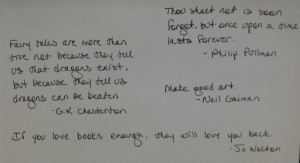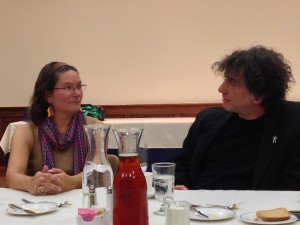A couple of weeks ago, I had the great good fortune to meet Neil Gaiman. He came to my university to talk about reading and writing and technology, and he also generously answered a wide range of questions from students (and me!) about his books and his writing process. When this picture was taken, he was talking to me about the Hempstocks, a family that appears in several of Neil’s books. (I won’t say which ones: I’ll leave the joy of bumping in to them in unexpected places to my readers who, I hope, are also Neil’s readers.) I love the idea of characters who live beyond the confines of any one book–I wrote about this very subject here–and I love that we discover these characters through careful, slow reading.
“Slow reading” is something we talk about in English departments. It means that we move carefully through a text so that we can notice and appreciate how the words work. There is certainly a place for fast reading, for devouring a wonderful book that you can’t put down, that won’t let you go, that consumes you, mind, body, and soul. But reading slowly is equally satisfying. When you read slowly, you discover that writers are magicians, that they take, to paraphrase Neil, the twenty-six letters of the alphabet and a handful of punctuation marks and make whole worlds. When you read slowly, you discover that characters like the Hempstocks are real, and if you look for them outside the binding of a book, you will find them. When you read slowly, you notice lovely turns of phrase and you can take the time to tuck those phrases inside yourself and make them part of the language you use to live in the world.
 These are the phrases I carry around with me these days. I sprinkle them across the places of my life: I put them on sticky-notes that I affix to my computer, I use them as epigraphs on my syllabi, and I actually carry them around in a leather-bound notebook. I discovered these phrases through slow reading, but in the notebook, they inspire me as I embrace slow writing.
These are the phrases I carry around with me these days. I sprinkle them across the places of my life: I put them on sticky-notes that I affix to my computer, I use them as epigraphs on my syllabi, and I actually carry them around in a leather-bound notebook. I discovered these phrases through slow reading, but in the notebook, they inspire me as I embrace slow writing.
When Neil spoke at Bucknell, he talked about his notebooks, and he inspired me to take up writing by hand. I like the idea of separating inspiration from keyboard and screen. I like the idea of producing an object that holds my ideas and will hold them long after I’ve moved on to other ideas. I like the idea of handwriting, of feeling the way the twenty-six letters and punctuation marks unspool and take shape.
So, I started writing in my notebook. Sometimes I make notes. Sometimes I free write. Sometimes I draft paragraphs or snippets of dialogue. Whatever I write, I write slowly. And in the beats, the pauses as my pen scrolls into the next letter, the next word, I find ideas. Writing slowly by hand, just like reading slowly, gives me the time and space to move more carefully through my own head.
I won’t stop composing fiction on my computer. But as I prepare to write books that I hope readers will both devour and read slowly, I will savor the inspiration that comes from writing slowly. I will use my notebook to compose myself.

